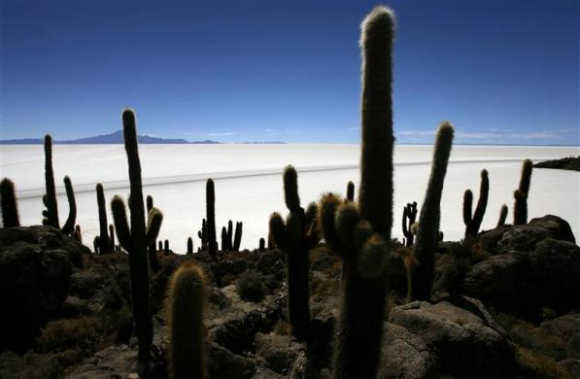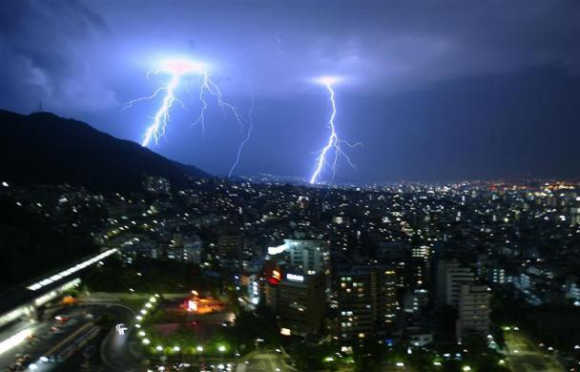 | « Back to article | Print this article |
Amazing images reveal the cost of global warming
Global warming is the rising average temperature of Earth's atmosphere and oceans since the late 19th century and its projected continuation.
Since the early 20th century, Earth's average surface temperature has increased by about 0.8 °C (1.4 °F), with about two thirds of the increase occurring since 1980.
Click NEXT to read more...
Amazing images reveal the cost of global warming
Warming of the climate system is unequivocal, and scientists are more than 90 per cent certain that most of it is caused by increasing concentrations of greenhouse gases produced by human activities such as deforestation and the burning of fossil fuels.
Click NEXT to read more...
Amazing images reveal the cost of global warming
An increase in global temperature will cause sea levels to rise and will change the amount and pattern of precipitation, and a probable expansion of subtropical deserts.
Click NEXT to read more...
Amazing images reveal the cost of global warming
Warming is expected to be strongest in the Arctic and would be associated with continuing retreat of glaciers, permafrost and sea ice.
Other likely effects of the warming include more frequent occurrence of extreme-weather events including heat waves, droughts and heavy rainfall, species extinctions due to shifting temperature regimes, and changes in crop yields.
Click NEXT to read more...
Amazing images reveal the cost of global warming
Warming and related changes will vary from region to region around the globe, with projections being more robust in some areas than others.
If global mean temperature increases to 4 °C (7.2 °F) above pre-industrial levels, the limits for human adaptation are likely to be exceeded in many parts of the world, while the limits for adaptation for natural systems would largely be exceeded throughout the world.
Click NEXT to read more...
Amazing images reveal the cost of global warming
Hence, the ecosystem services upon which human livelihoods depend would not be preserved.
Click NEXT to read more...
Amazing images reveal the cost of global warming
Most countries are parties to the United Nations Framework Convention on Climate Change, whose ultimate objective is to prevent dangerous human-induced climate change.
Click NEXT to read more...
Amazing images reveal the cost of global warming
Parties to the UNFCCC have adopted a range of policies designed to reduce greenhouse gas emissions and to assist in adaptation to global warming.
Click NEXT to read more...
Amazing images reveal the cost of global warming
Parties to the UNFCCC have agreed that deep cuts in emissions are required, and that future global warming should be limited to below 2.0 °C (3.6 °F) relative to the pre-industrial level.
Click NEXT to read more...
Amazing images reveal the cost of global warming
A 2011 report of analyses by the United Nations Environment Programme and International Energy Agency suggest that efforts as of the early 21st century to reduce emissions may be inadequately stringent to meet the UNFCCC's 2 °C target.
Click NEXT to read more...
Amazing images reveal the cost of global warming
Evidence for warming of the climate system includes observed increases in global average air and ocean temperatures, widespread melting of snow and ice, and rising global average sea level.
Click NEXT to read more...
Amazing images reveal the cost of global warming
Recent estimates by Nasa's Goddard Institute for Space Studies and the National Climatic Data Center show that 2005 and 2010 tied for the planet's warmest year since reliable, widespread instrumental measurements became available in the late 19th century, exceeding 1998 by a few hundredths of a degree.
Click NEXT to read more...
Amazing images reveal the cost of global warming
Temperatures in 1998 were unusually warm because global temperatures are affected by the El Nino-Southern Oscillation, and the strongest El Nino in the past century occurred during that year.
Click NEXT to read more...
Amazing images reveal the cost of global warming
Global temperature is subject to short-term fluctuations that overlay long term trends and can temporarily mask them. The relative stability in temperature from 2002 to 2009 is consistent with such an episode.
The year 2010 was also an El Nino year.
Click NEXT to read more...
Amazing images reveal the cost of global warming
Temperature changes vary over the globe. Since 1979, land temperatures have increased about twice as fast as ocean temperatures (0.25 °C per decade against 0.13 °C per decade).
Click NEXT to read more...
Amazing images reveal the cost of global warming
Ocean temperatures increase more slowly than land temperatures because of the larger effective heat capacity of the oceans and because the ocean loses more heat by evaporation.
Click NEXT to read more...
Amazing images reveal the cost of global warming
The Northern Hemisphere warms faster than the Southern Hemisphere because it has more land and because it has extensive areas of seasonal snow and sea-ice cover subject to ice-albedo feedback.
Click NEXT to read more...
Amazing images reveal the cost of global warming
Although more greenhouse gases are emitted in the Northern than Southern Hemisphere this does not contribute to the difference in warming because the major greenhouse gases persist long enough to mix between hemispheres.
Click NEXT to read more...
Amazing images reveal the cost of global warming
The thermal inertia of the oceans and slow responses of other indirect effects mean that climate can take centuries or longer to adjust to changes in forcing.
Climate commitment studies indicate that even if greenhouse gases were stabilized at 2000 levels, a further warming of about 0.5 °C (0.9 °F) would still occur.
Click NEXT to read more...
Amazing images reveal the cost of global warming
External forcing refers to processes external to the climate system (though not necessarily external to Earth) that influence climate.
Climate responds to several types of external forcing, such as radiative forcing due to changes in atmospheric composition (mainly greenhouse gas concentrations), changes in solar luminosity, volcanic eruptions, and variations in Earth's orbit around the Sun.
Click NEXT to read more...
Amazing images reveal the cost of global warming
Attribution of recent climate change focuses on the first three types of forcing.
Click NEXT to read more...
Amazing images reveal the cost of global warming
Orbital cycles vary slowly over tens of thousands of years and at present are in an overall cooling trend which would be expected to lead towards an ice age, but the 20th century instrumental temperature record shows a sudden rise in global temperatures.
Click NEXT to read more...
Amazing images reveal the cost of global warming
The greenhouse effect is the process by which absorption and emission of infrared radiation by gases in the atmosphere warm a planet's lower atmosphere and surface.
Click NEXT to read more...
Amazing images reveal the cost of global warming
Human activity since the Industrial Revolution has increased the amount of greenhouse gases in the atmosphere, leading to increased radiative forcing from CO2, methane, tropospheric ozone, CFCs and nitrous oxide.
Click NEXT to read more...
Amazing images reveal the cost of global warming
The concentrations of CO2 and methane have increased by 36 per cent and 148 per cent respectively since 1750. These levels are much higher than at any time during the last 800,000 years, the period for which reliable data has been extracted from ice cores.
Click NEXT to read more...
Amazing images reveal the cost of global warming
Less direct geological evidence indicates that CO2 values higher than this were last seen about 20 million years ago.
Click NEXT to read more...
Amazing images reveal the cost of global warming
Fossil fuel burning has produced about three-quarters of the increase in CO2 from human activity over the past 20 years.
The rest of this increase is caused mostly by changes in land-use, particularly deforestation.
Click NEXT to read more...
Amazing images reveal the cost of global warming
Over the last three decades of the 20th century, gross domestic product per capita and population growth were the main drivers of increases in greenhouse gas emissions.
Click NEXT to read more...
Amazing images reveal the cost of global warming
CO2 emissions are continuing to rise due to the burning of fossil fuels and land-use change. Emissions can be attributed to different regions.
Click NEXT to read more...
Amazing images reveal the cost of global warming
Vulnerability of human societies to climate change mainly lies in the effects of extreme-weather events rather than gradual climate change.
Impacts of climate change so far include adverse effects on small islands, adverse effects on indigenous populations in high-latitude areas, and small but discernable effects on human health.





























